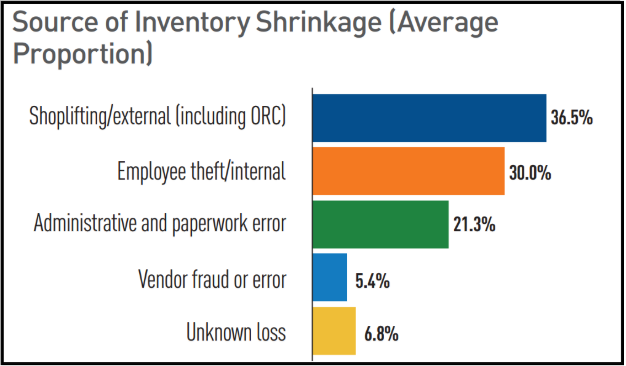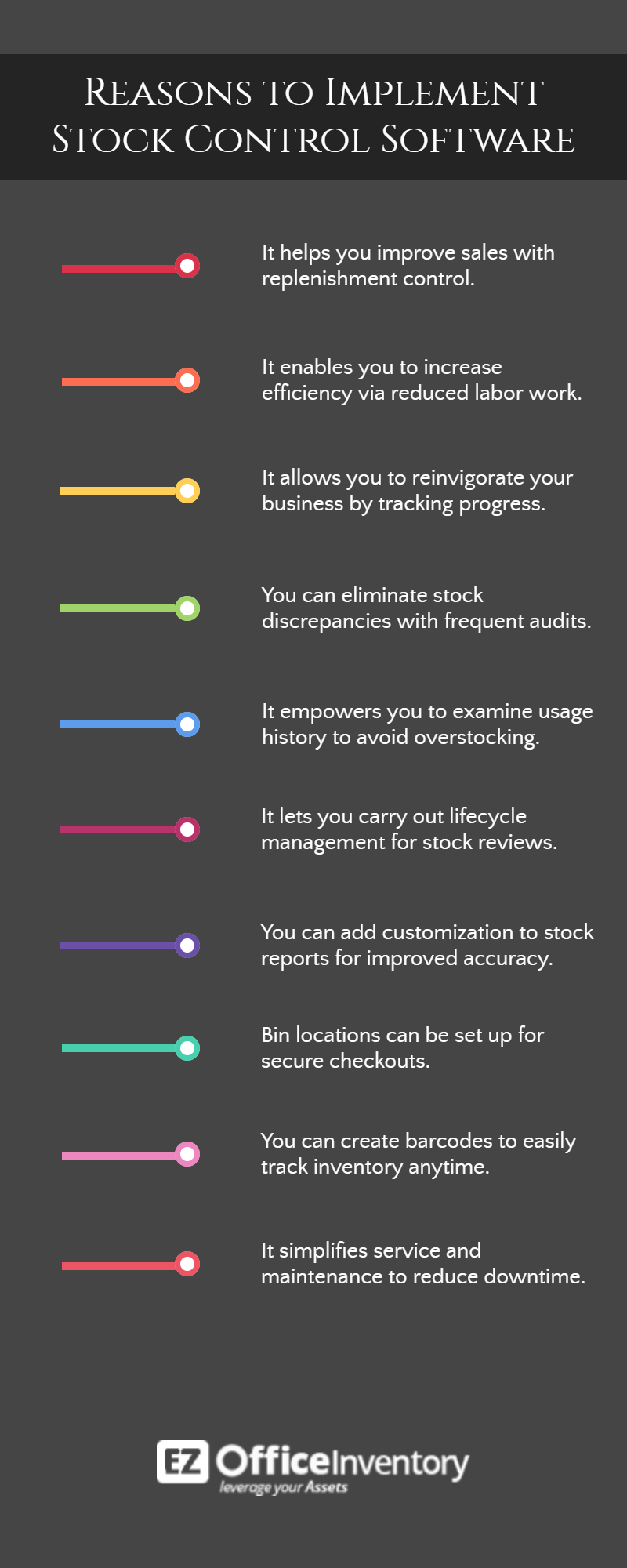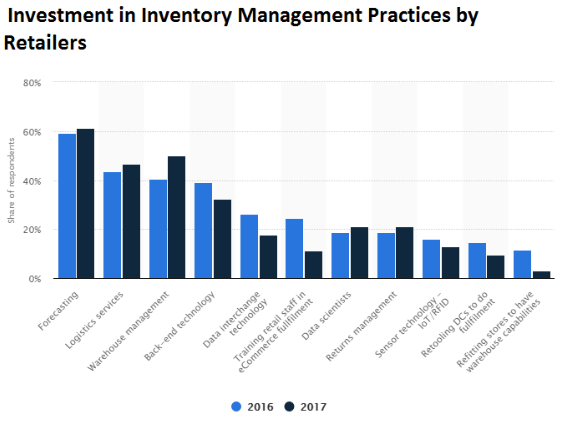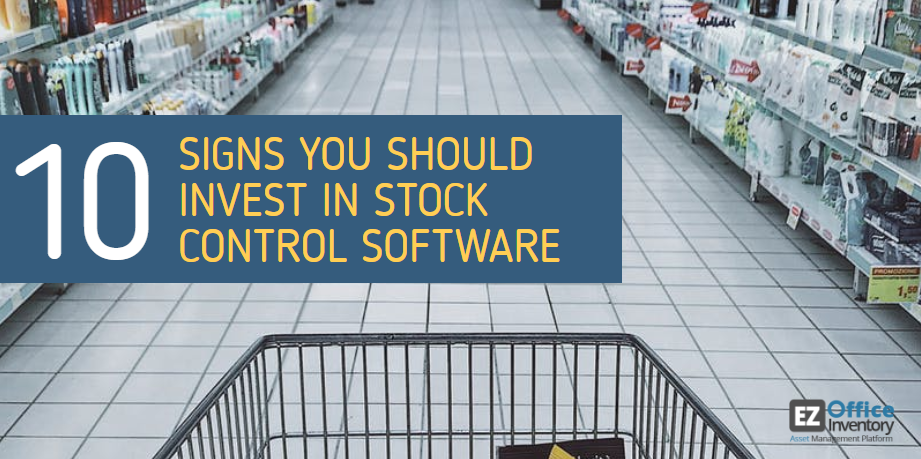The role of stock control software in managing inventory
What is stock control?
Business inventory management is a serious challenge for both small and medium-sized firms. In order to tackle this problem, a majority of companies opt for a stock control software. According to a study by National Retail Security Survey, it was found out that vendor and administrative errors account for 25% shrinkage in inventory. By exercising robust stock control, these errors can be minimized through regulating supply chain practices and enabling optimal resource allocation. The ultimate goal is to increase the rate of return while gaining higher productivity levels.
Before you can implement a customized inventory control routine, you need to categorize your stock into different types, relevant to its usage. A few common types of inventory are:
- Merchandise inventory
- Manufacturing inventory
- Raw materials
- Finished goods
- Packing material
- MRO goods

Other than these, businesses oftentimes hold the stock for emergency situations or certain transactions. These include, goods in transit, buffer inventory, anticipatory stock and decoupling inventory. The key purpose of carrying out stock control is to limit the costs associated with inventory management. Doing this ensures that firms have optimal quantities at all times to meet customer demands. Such a proposition might sound simple to implement but can turn out to be challenging. It is due to the fluctuations in demands or issues related to storage.
The control of stock comprises a variety of workflows, focused towards harnessing the best possible outcomes for your business. Starting off from warehouse management where you monitor and track usage and storage to deciding on optimal inventory levels – all fall under stock control systems.
You can also check-in damaged assets for maintenance and repair. This helps to prolong their useful life for better performance. Basically, there are two ways to go about this, manually or by using a cloud-based software. Depending on your daily activities, you can adopt the mechanism which fits your requirements.
Stock control policies and procedures
In order to establish a few ground rules for stock control, it is best to understand what you ultimately want to achieve. The majority of organizations follow common policies which help them reach their desired yearly targets. When deciding retail and distribution services, it is important to keep some essential procedures in mind:
- Implementing limited access to inventory: This is usually preferred when only the concerned departments should be able to use and update inventory data.
- Work with multiple sites to replenish stock: Having more than one supply center allows you to minimize costs.
- Learn to track annual and yearly demand trends: Doing this provides you with competitive data, extremely handy for startups and small firms.
- Monitor existing stock: Lack of knowledge about the insufficient stock can limit sales. On the other hand, the excessive stock can tie up money that might be needed somewhere else.
- Document inventory processes: Easily available data lets you run reviews on current policies and make the required improvements.
- Send out stock alerts: This helps to notify management about stock limits so that new inventory can be ordered.

Once you figure out the nature of your workflows, it becomes easier to design and follow stock control policies and procedures.
Responsibilities of inventory managers
Every company designates a team responsible for carrying out inventory control. Basically, they overlook everything from organizing an order to the disposal of used items. Employees put forward their needs to the administration where inventory managers further process and shortlist the demands. The easiest strategy is to create a checklist. The list makes the process easier every time a new tool is to be purchased.
First of all, the administration head gathers a list of everything that is needed. The correct way to go about this is to maintain a manual or web-based log of all these items.
Next, when your list is finalized, you compare your order list to the existing stock. There is no point in overstocking on what is already in storage. After deciding which stock items need replenishment, you send the order off to the supplier. Before doing this, you can always select from the list of available vendors to minimize distribution costs, if possible. It is important to check for confirmation from vendors once they have received your order.
Did you know? Survey results show that around 46% small businesses use previous month’s information for inventory reordering decisions.
Once the inventory arrives, an inventory manager conducts a quality inspection. It is good for your business if everything is up to the standard. Doing this is important because oftentimes, tools can break down during delivery or because of a defected piece. Under such incidences, the order should be returned to the vendor. If a surplus stock has been purchased, then it should be redirected to the warehouse for storage.
The second step involves processing of the order. This means the admin managers have to update the inventory database and allocate stock as required. For instance, the IT department put in a request for a new printer. Upon arrival, the printers will be delivered, installed and run through an initial testing phase. After the successful completion of all these stages and approval from the IT department, the inventory manager records the order as closed.
In cases of any technical malfunction, the employees must report back to the administrator. The inventory manager then gets in touch with the manufacturer for repair and maintenance.
Stock control challenges and opportunities
Due to the change in demands, it can be quite difficult to keep up with the market trends. For this reason, an absence of a robust stock control software can have a negative impact on business progress. To tackle such issues, it is crucial to understand the challenges that might arise for warehouse managers:
- Classifying different types of stock: Keeping a well-organized inventory makes it easier to track and record. For this purpose, you can divide it into safety stock, replenishment stock, and normal stock to maintain adequate levels.
- Determining optimal stock levels: This can be tricky to do since it involves serious analysis of past consumption trends and future market demands. Oftentimes, it happens that you’re out of hot selling items but your warehouse is still overloaded. The reason behind this is simple! You ordered incorrect assets. To improve forecasting, pay attention to varying factors to quickly adapt to changes.
- Managing multiple locations: For companies which operate in different regions across cities, losing stock in transit is a common problem. To cut down such inefficiencies, firms can tag all inventory items using unique codes. These labels can then be entered while checking out assets across locations. Instantly updated systems allow you to monitor usage from a single point of access.
The ideal way to overcome these hurdles would be to plan a streamlined procurement routine which deals with everything. That can be from creating purchase orders to sending out tools for maintenance. Studying usage history makes it possible to revise your stock orders to meet the current demands.
For instance, the projectors in a school break down. This will be reported to the concerned admin officer and the projectors will be checked in for a service session. Known as preventive maintenance, this workflow also forms part of a stock control practice and lets you optimize your inventory.
What is stock control software?
Without a clearly defined business strategy, it is quite tedious to monitor inventory levels at all times. To run streamlined workflows, companies often invest in a stock control software. This is a cloud-based mechanism which allows you to automate daily tasks for improved performance and increased RO. Being easily accessible through employee login systems, this program increases collaboration and allows multiple users at a single time.

With the latest software updates available, this system lets you scale up easily whenever you expand your inventory or stock in different types of assets. You can create customized stock entries suited to your work operations to minimize data errors.
10 Signs you need stock control software for your company
Poor inventory control practices can lead to a loss in production time and inefficient workflows. Determining optimal quantities is only possible if you have the required usage data throughout the business year.
Here are ten ways you can use stock control software to upgrade inventory utilization for better business outcomes:
1. Improve sales with replenishment control: Running out of stock during work projects can damage your sales adversely. Shortage of inventory causes delays and even be costly if deadlines are not met. Employee productivity goes down as well if they cannot meet their daily targets. To avoid such unwanted situations, a stock control software lets you automate procurement.
By using this feature, you can automate purchase of new stock and ensure that you never face untimely asset deficit. Having met the demands of the consumer, your sales are more likely to increase.
2. Increase efficiency through reduced manual labor: While working with a manual stock control system, an organization is more likely to experience repetition which leads to redundancy in tasks. A proactive way to eliminate such errors would be to establish a computerized inventory control system. All data stored online on the cloud is highly accurate and protected against unauthorized use.
3. Reinvigorate your business by tracking progress: Obsolete systems of data collection can also lead to stock control problems. If you are tracking inventory in the right way then you are likely to fall behind on your goals. In cases of such malpractices, it is better to adopt a computerized stock control software which allows you to analyze any deviations from your targets. The correct tools for the job will let you achieve a lot more.
4. Eliminate stock discrepancies with frequent audits: Sometimes, organizations struggle with keeping a record of how much inventory they actually have in stock. Error to do so results in stock discrepancies which can be misleading. It results in financial losses as well. A simple way to tackle such issues would be to carry out regular audits to monitor the current status of all tools. This also allows you to track ownership of inventory. It enables you to verify asset transactions and update your database.
5. Examine usage history to avoid overstocking: Buying certain stock in surplus can be more of a disadvantage than a gain for your business. Mostly because excess in inventory ties up money which could’ve have been used somewhere else. It is more likely to go to waste if the market demand changes in the next season. In such circumstances, you are forced to dispose of the unused stock. The best way to decide optimal quantities is to review previous trends and how asset usage has evolved over time.
6. Carry out lifecycle management for efficient stock reviews: How long before you need to discard certain items in your inventory? The answer to that lies in effective lifecycle management by a stock control software. You can easily conduct seamless asset reviews and check the current status of different types of stock. Account for suitable depreciation practices and dispose of inventory in time before ordering the new one.
7. Add customizations for accurate stock reporting: Maintaining optimal levels of stock alone isn’t of much use unless you record it precisely as well. Companies have unique products which require specific types of raw materials to make. To create a reliable database, it is important to document stock in the correct manner. This can be done by adding customized templates to your information system. Such a mechanism helps in data collection and stores the tiniest details.
8. Set ‘bin’ locations with secure checkouts: Being able to place inventory in the warehouse correctly can be a complicated task. One of the key factors of stock control is to manage inventory placements. By implementing a check-in and checkout system for all your assets, you can easily record locations. Doing so helps to define inventory position in the warehouse for easy retrieving, restocking and counting.
9. Create barcodes to easily trace inventory: Assets without labels can be hard to track. If you are not able to trace inventory movements then you miss out on important data. One way to do this is to tag all stock items with a barcode label. This can hold serial numbers of multiple locations to make tracking much more simplified.
10. Run service sessions to reduce downtime: Particular inventory items tend to expire and need to be replenished in time to ensure smooth workflows. Faulty stock items should be fixed as soon as possible to avoid delays. A stock control software lets you run maintenance sessions to deal with unexpected downtime. You can choose from a list of vendors to send in your tools for service events. It helps you to cut down on excessive replacement costs.
Conclusion
Sporadic stock management is the main cause of slow business performance and reduced inventory growth. The best way to tackle such malpractices is to characterize costs and lay down the negative impacts of haphazard procurement. To start off, you can provide precise data and effective tools for stock control to purchasing agents. One such tool is EZOfficeInventory – a stock control software which allows companies to balance costs, automate check-ins and checkouts and run streamlined inventory reports and reviews.
Implementing a strong methodology to understand the true cost of stock discrepancies or overstock issues motivates the right business decision-making process. Doing this lets you quantify the consequence of each cost variable when it comes to procurement. Inconsistent supplier performance can be dealt with by providing feedback, thus, reducing the excess in inventory and stock-outs.
Learn more about EZOfficeInventory!
EZOfficeInventory is a cloud-based inventory management software that helps thousands of companies manage inventory and warehouse stock tracking workflows, conduct maintenance events, cut costs and streamline processes all over the world.








